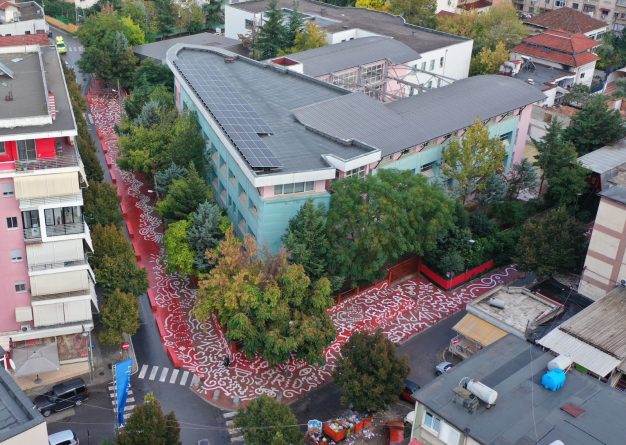
School Streets set to double in Tirana – the city which ‘everyone can learn from’
The surging popularity of ‘School Streets’ already has a firm foothold in the Albanian capital, Tirana, with 10 already completed or under construction.
But far from resting on its laurels, the city is determined to proudly position itself as a shining example of how a truly dynamic approach to improving children’s lives can bring tangible change – and to prove this it has secured investment of almost one million Euros so to invest in 20 new permanent streets.
Erion Veliaj, the Mayor of Tirana, announced the introduction of ‘Rrugët për Fëmijët’ – Streets for Kids – which applies some simple traffic infrastructure design changes to make school drop-off and pick-ups a much calmer, safer experience for the city’s children, parents and guardians.
“When we decided to take kids seriously in this city, schools were the logical place to start – we are incredibly proud to build this legacy of safety for every child in Tirana for decades to come,” said Mayor Veliaj, who added that the city’s total budget was being increased to 340 million euros, which is more than ten times what it was in 2015.
‘Schools were the logical place to start’
This new initiative represents what organisers call a ‘remarkable’ scaling-up of a programme that first began in 2020, with Tirana-based urban design nonprofit outfit Quendra Marrëdhënie providing the design expertise, backed by funding from international donors.
These pilots were put in place by the city’s maintenance department, led by Erind Bejko, director of the Department of Roads and Public Lighting, which provided the base for testing of materials and techniques to ensure long-term durability.
It means that in addition to the ten already up and running or being constructed, a further 20 ‘school streets’ will be in place by the end of this year, covering some 40 per cent of Tirana’s schools. This, says the city, will directly affect 25,000 students and add over 8,000m2 of public space less than a five-minute walk from home for hundreds of thousands of residents.

It demonstrates the commitment shown by an administration that has steadily built an international reputation as one of the world’s leading child-friendly municipalities.
Since first being tested in the Italian city of Bolzano in 1989, school streets have rocketed in popularity, and particularly so since the COVID pandemic. And although this latest investment in Tirana amounts to some 990,000 Euros, it remains the case that improvements needed to make streets safer and more appealing to children can often quick and inexpensive.
Barcelona’s ‘Protegim les Escoles,’ the ‘Strade Scolastiche’ in Milan, and ‘Rues aux Écoles’ in Paris are just three examples across the European Union, while in the UK this concept has seen a similar explosion in popularity, such as this one in Redbridge, East London, which by September will have some 14 schools involved.
Simon Battisti, director of Qendra Marrëdhënie, said: “School streets not only improve safety where children and parents need it most, but they also kick-start a larger conversation about shifting priority away from cars to pedestrians in the city. Cities everywhere can learn from what Tirana has been able to do over the past eight years. We’re seeing it all add up and it’s historic change.”
‘We’re seeing it all add up’
Anuela Ristani, the Deputy Mayor of Tirana and the person leading the programme on the city’s behalf, is keen to reiterate the importance of providing residents with better alternatives to move around the city: “Our streets are clogged and when you ask people why that is, the answer is always the same: ‘Albanians love their cars.’ I don’t think that’s really the case. I am pretty sure it is because walking is still often just too uncomfortable. That has to change and projects like the school streets show that that change is not only possible, but it’s quick.

“At the same time we also have to ask ‘who is actually driving?’ We know most people behind the wheel on a given day in Tirana are men. We know kids under 16 don’t drive, and we know that very few elderly drive. Our school streets show loud and clear what we sacrifice by choosing to store cars on the street instead of using that precious public space for people,” he added.
Rrugët për Fëmijët has been made possible thanks to initial funding in 2020 from Global Designing Cities Initiative’s Streets for Kids program, followed by support from GIZ and Bloomberg Philanthropies. It is the intention that it will operate over the next three years, and that the ultimate aim is to have every primary school in Tirana protected by 2026.
Click here for more on Qendra Marrëdhënie and here in particular its work on the Tirana School Streets Program.




